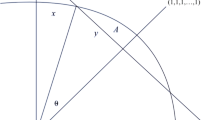Abstract
Distance-based methods have been a valuable tool for ecologists for decades. Indirectly, distance-based ordination and cluster analysis, in particular, have been widely practiced as they allow the visualization of a multivariate data set in a few dimensions. The explicitly distance-based Mantel test and multiple regression on distance matrices (MRM) add hypothesis testing to the toolbox. One concern for ecologists wishing to use these methods lies in deciding whether to combine data vectors into a compound multivariate dissimilarity to analyze them individually. For Euclidean distances on scaled data, the correlation of a pair of multivariate distance matrices can be calculated from the correlations between the two sets of individual distance matrices if one set is orthogonal, demonstrating a clear link between individual and compound distances. The choice between Mantel and MRM should be driven by ecological hypotheses rather than mathematical concerns. The relationship between individual and compound distance matrices also provides a means for calculating the maximum possible value of the Mantel statistic, which can be considerably less than 1 for a given analysis. These relationships are demonstrated with simulated data. Although these mathematical relationships are only strictly true for Euclidean distances when one set of variables is orthogonal, simulations show that they are approximately true for weakly correlated variables and Bray–Curtis dissimilarities.



Similar content being viewed by others
References
Dutilleul P, Stockwell J, Frigon D, Legendre P (2000) The Mantel test versus Pearson’s correlation analysis: assessment of the differences for biological and environmental studies. J Agric Biol Environ Stat 5:131–150
Goslee S, Urban D (2007) The ecodist package for dissimilarity-based analysis of ecological data. J Stat Soft 22(7):1–19
Legendre P (2000) Comparison of permutation methods for the partial correlation and partial Mantel tests. J Stat Comp Simul 67:37–73
Legendre P, Legendre L (1998) Numerical ecology. Elsevier, Amsterdam
Legendre P, Lapointe FJ, Casgrain P (1994) Modeling brain evolution from behavior: a permutational regression approach. Evolution 48:1487–1499
Lichstein J (2007) Multiple regression on distance matrices: a multivariate spatial analysis tool. Plant Ecol 188:117–131
Mantel N (1967) The detection of disease clustering and a generalized regression approach. Cancer Res 27:209–220
McCune B, Grace J (2002) Analysis of ecological communities. MjM Software, Gleneden Beach, Oregon
Qiu W, Joe H (2007) clusterGeneration: random cluster generation (with specified degree of separation). R package version 1.2.4
R Development Core Team (2008) R: a language and environment for statistical computing. R Foundation for Statistical Computing, Vienna, Austria, http://www.R-project.org, ISBN 3-900051-07-0
Urban D, Goslee S, Pierce K, Lookingbill T (2002) Extending community ecology to landscapes. Ecoscience 9:200–212
Venables W, Ripley B (2002) Modern applied statistics with S, 4th edn. Springer, New York
Acknowledgments
We thank Dean Urban and two anonymous reviewers for their useful comments on earlier versions of this article.
Author information
Authors and Affiliations
Corresponding author
Rights and permissions
About this article
Cite this article
Goslee, S.C. Correlation analysis of dissimilarity matrices. Plant Ecol 206, 279–286 (2010). https://doi.org/10.1007/s11258-009-9641-0
Received:
Accepted:
Published:
Issue Date:
DOI: https://doi.org/10.1007/s11258-009-9641-0



